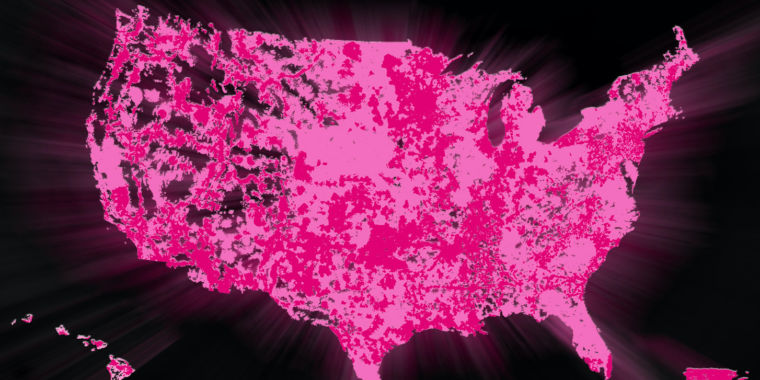T-Mobile today announced that it has launched "America's first nationwide 5G network," but T-Mobile's definition of "nationwide" doesn't include about 40% of the US population.
"America gets its first nationwide 5G network today, covering more than 200 million people and more than 1 million square miles," T-Mobile's announcement said.
The US Census Bureau estimates the population to be more than 330 million people. T-Mobile hasn't actually forgotten about the other 130 million people in the US, as a sentence halfway through the carrier's press release notes that "T-Mobile's network covers more than 60 percent of the population." At 1 million square miles, the carrier's 5G network also covers about 28% of the country's 3.53 million square miles, and it's far short of the geographical reach already provided by T-Mobile's 4G network.
We asked T-Mobile to explain why it defines "nationwide" as "60 percent of the population." T-Mobile did not answer that question.
T-Mobile's 4G LTE network covers more than 325 million people.
US coverage map is mostly 4G
T-Mobile said its 5G network today reaches "more than 5,000 cities and towns all across the country," and the company published a list of those places. There are 19,495 incorporated places in the US.
Despite its actual coverage, T-Mobile's announcement uses the word "nationwide" to describe the current reach of its 5G network a dozen times while admitting that "coverage [is] not available in some areas." In the coverage map provided by T-Mobile, which is at the top of this article, you can see that the 5G areas displayed in a darker shade of pink don't include huge portions of the country covered by T-Mobile 4G. Alaska is excluded entirely.
T-Mobile CEO John Legere today posted a tweet announcing the "first nationwide 5G" network and a video in which he says that "nationwide 5G is live." But Legere did not specify in the tweet or video that the nationwide 5G excludes 40% of the US population.
First *NATIONWIDE* 5G
That's the @TMobile way
#Nationwide5G
— John Legere (@JohnLegere) December 2, 2019
The 5G service T-Mobile announced today isn't much faster than T-Mobile's 4G service. That's because the "nationwide" 5G covering 60% of the population uses the same 600MHz spectrum that T-Mobile already uses for 4G. The big speed increases on 5G are expected to come from millimeter-wave spectrum, but those higher frequencies don't travel as far and are being used primarily in densely populated urban areas.
AT&T acknowledged last month that its 5G service on low-band spectrum offers only 4G-like speeds this year, with actual speed increases coming next year. Verizon has said that 5G on low-band spectrum will be more like "good 4G," and T-Mobile said in April that millimeter-wave 5G "will never materially scale beyond small pockets of 5G hotspots in dense urban environments."

Speeds to rise 20% on average
T-Mobile's press release today doesn't say what speeds customers will get from 5G on 600MHz spectrum. We asked T-Mobile what the 5G-over-600MHz network's current speeds are, and the carrier gave us this answer:
In some places, 600MHz 5G will be a lot faster than LTE. In others, customers won't see as much difference. On average, customers with a 600MHz 5G phone should see a 20 percent download speed boost on top of what T-Mobile's LTE network delivers, and they can expect that to get exponentially faster over time, just like we saw when 4G was first introduced.
T-Mobile's average 4G download speeds were 21.9Mbps, according to OpenSignal research published in January 2019. A 20% increaseRead More – Source







